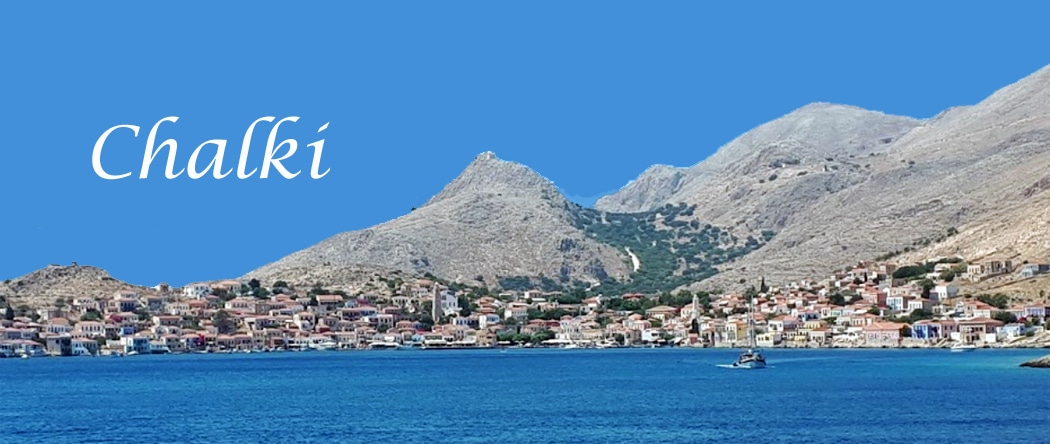Information about the island of Halki
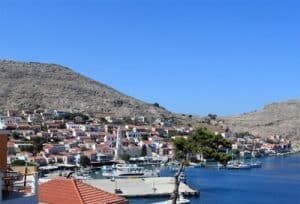
As soon as you get there, you are greeted by a colorful settlement, made up of beautiful neoclassical buildings, painted in bright colors, the beautiful Niborio, where it is the only settlement and port of the island. Stone-built colored houses with tiled roofs give them the “stigma” of the island, in the shadow of the imposing bell tower of Agios Nikolaos, the island’s patron saint.
At a distance of about 2.5 kilometers from the port is Chorio, the old capital of the island. In the Castle of the Knights, only the church of Agios Nikolaos is preserved, with frescoes from the 15th and 17th centuries, but the view of the Carpathian sea is worth it and will be unforgettable.
The Old Village has been designated a cultural landmark by UNESCO and its architectural integrity is protected with strict criteria. Niborio (Himboreios) is also a strictly preserved settlement and all renovations and restorations of buildings must be done with a view to preserving the unique character of Halki.
About Halki
Halki is an ideal proposal for those who want to fill their suitcases with books and relax, without a lot of travel. The puppet port, Niborio, with its stone mansions is also the only settlement.
Unfortunately, the best houses are exclusively rented through British travel agencies and the only accommodation solutions for the rest are the few hotels and rentals.
Secularity is an unknown word, since the taverns are measured on the fingers and the nightlife runs out in cafes-bars. The car is unnecessary, although a motorbike would relieve you of the ten-minute daily walk to the beach of Potamos (a sandy beach with a few tamarisk trees, a tavern and a canteen), which gathers a lot of people.
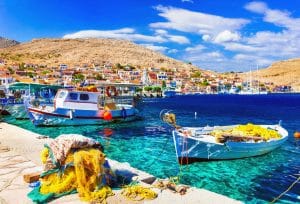
You will go to the rest of the beaches (unless you are dedicated trekkers) by boat. However, even the waters at the edges of the port, no matter how strange it may sound to you, are very clean and offer swimming opportunities with a view of the picturesque settlement.
It is also worth visiting the now deserted Old Village (an hour’s walk) to enjoy the sunset from the ruins of the Fortress of the Knights of Agios Ioannis. In the Monastery of Agios Ioannis with its wonderful pebbled floor, a festival takes place on August 29 with a great feast.
Villages
There is only one settlement, Halki or Nimborio, capital and port of the island, amphitheatrically built around the closed harbour – protected by the islets Nisos and Krevati – with its uniform two-storey and three-storey, tile-roofed, stone-built houses, a settlement glowing with nobleness. Behind the town rise the bare and steep rocks of the island.
The hills are not high and Maistro, the highest crest in the central-eastern part of the island, has an altitude of only 500 meters. Halki has been proclaimed a traditional settlement and was honored to become a municipality. It was founded in 1850-1879 by the island’s dwellers.
History
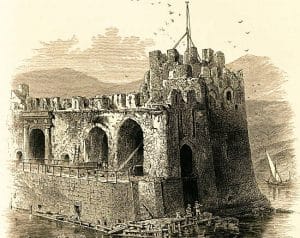
In the historic period, from time to time Halki was believed to depend on Kamiros, while in the tax lists of the Delos Alliance it appeared as an ally of the Athenians, suggesting that at that period it was an independent administrative entity.
Later, it again seemed to depend on Kamiros and in the subsequent centuries it followed the rise and fall of Rhodes. In the 12th century, the Knights of Rhodes gave Halki as a feudal property to the Assanti family of Ischia.
At that time the fortress was built on the ruins of the ancient acropolis where the population found refuge in case of raid. Since the mid 19th century Halki, then under Turkish occupation, reached the apogee of its prosperity. Together with Symi, Kalymnos and Kastelorizo, they developed trade and sponge-fishing. Schools were founded and the educational level of the population rose impressively.
In the last years of Turkish occupation and during Italian occupation the long-inherited privileges were abolished, trade and sponge-fishing were hit and the hemorrhage of migration started. In 1912 Halki and the Dodecanese as a whole came under Italian dominance, military and political after 1923.
During World War II Halki won glory due to the struggles and the blood of its merited children such as lieutenant Alexandros Diakos and captain Diogenis Fanourakis. Read more about the history of Halki.
Geographic Information
In general, the terrain of Halki is semi-mountainous and barren. Higher peaks are Merovigli (593 m.) in the NE. part of the island and Prophet Ilias (578 m.) in the central part. The coasts are mostly steep and rocky with small beaches with sand and pebbles mainly in the northern and southern parts of the island. The waters of the sea around the island are the clearest that anyone has ever seen.
To the South East is Cape Krevati, to the north of which stretches the bay of Emporios at the head of which is the homonymous village of Halki, or Imborio. The settlement is beautiful, with houses of neoclassical architecture, which reveal the grandeur of other times. The North East ends at Cape Limanari, while to the North West a small peninsula is formed that ends at Cape Kefalos.
The general appearance of Halki is characterized as mountainous, but the mountainous complexes are interrupted by small or large plains, such as the valleys of Zion, Pontamos, Lentaki, Kissos, etc. In these valleys there was during ancient times a rich production of cereals which was favored by the soil and the mild meridian climate of Halki. “.
It is noted that between Halki and Rhodes there are many small islets, rocky islets and reefs that need special attention. The largest of these islets is Alimia.
With the implementation of the new administrative division of the country (Kallicratis program) in 2011, there was no change in the administrative situation of the Municipality of Halki, according to article 1, par. 2.10.C.
Based on the above, the Municipality of Chalki includes the island of Chalki and the islets: Agios Theodoros, Nisaki, Alimia, Kato Prasoua, Kolofonas, Krevati, Maelonisi, Makri, Nipouri, Pano Prasoua, Strogyli, Sfyra, Tragousa, Tsouka, Plateia Island.
What to see
Ancient monuments and archeological sites
The Town hall is a neoclassical building of the 19th century. In front of it there is a stone-built tower with a clock.
The three wind mills are high up in the mountain.
The old Chorio, uninhabited today, was the old capital of Halki. 4.000 people used to live here, withdrawn from the sea out of fear of the corsairs and of Morozini’s pirates. Its stony houses are amphitheatrically built on the hill of the fortress.
The ancient settlement of Halki
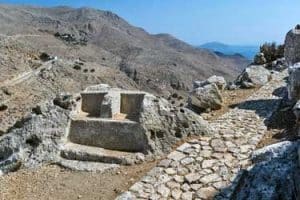
Also, at the top of the hill, part of the foundations of the ancient wall is preserved, integrated into the walls of the medieval castle. Between the stone-built abandoned houses of the medieval settlement, the retaining walls of the ancient houses are preserved.
Near the top of the hill two thrones have been carved into the rock with the inscription “Dios Ekatis”. A small temple dedicated to the god Asklepios was probably built here, according to a votive inscription of the god’s priest.
The ancient necropolis of Halki
The ancient necropolis of Halki extended at the foot of the hill where the medieval settlement of Chorio was until the beach of Pontamos, outside Niborio. During the opening of the road in the 60s came to light chamber tombs carved into the rock, still visible today.
On the beach of Pontamos, nineteen graves were investigated by the Italians in 1931, in which important gifts were found, mainly red-figured Attic vases of the 4th century. BC.
Among them it is worth mentioning a red-figured epinitro (an accessory for spinning wool), with depictions of women in everyday occupations, and a red-figured ryto with relief faces of Herakles and Silenus, which are currently in the Museum of Rhodes
Monasteries and Churches
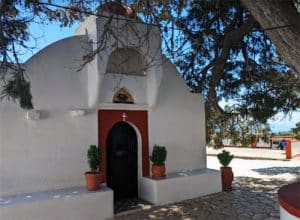
Note that on August 29 the monastery celebrates and in its honor the biggest festival of the island is held. Also, the Church of Panagia dominates the wild landscape. The building dates from 1400 – 1600 BC, while inside you will admire wonderful frescoes. The church celebrates on the 15th of August and on the eve of the feast, the whole village gathers there.
The monastery of Taxiarhis Michael, 5 km to the north west of the island hosts a rare icon of the saint.
The Aghia Triada monastery, near Ai Yiannis has a view over Tilos.
The church of Aghios Nikolaos, protector of the town, has a grandiose bell-tower, a wooden-carved iconostasis of rare art and hagiographies. It was founded in 1861.
The church of Aghios Eleftherios is near Chorio and that of Stavros is higher up.
Nimborio
The island’s only settlement, Niborio, is built amphitheatrically around the sheltered harbor, with the two islets of Nisos and Krevvatia standing protectively at the harbor opening like sleepless sentinels, facing the uniform two- and three-story stone-built houses with balconies , the colored windows and the tiled roofs.
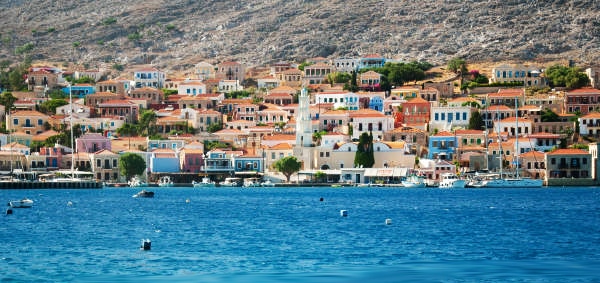
The settlement has been characterized as traditional and exudes an indescribable nobility, at the same time with a sense of melancholy, as one realizes how many of these beautiful residences are today abandoned.
But they stand there, always proud, with their backs resting as if on the bare hills, which surround the small town giving it grandeur and charming mystery.
Highlights the bell tower of Agios Nikolaos, which rests on an arch made of ancient marble from the temple of Apollo, but also the Clock, the Town Hall and the Post Office, which were built during the Italian occupation.
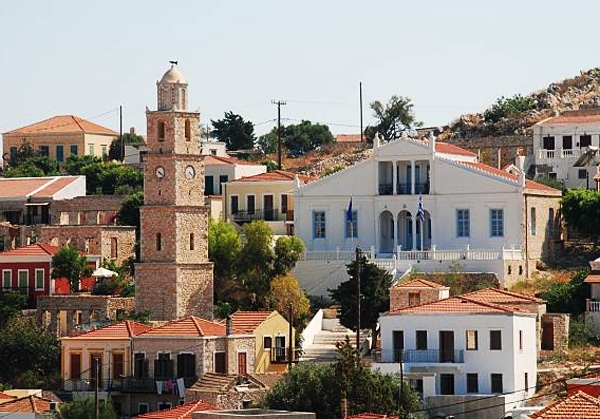
Fortress of the Knights of St John
Built in the 15th century, in the northeast of the island, above the well-preserved castle of the Hellenistic times and next to the ruins of an ancient city.
The fortress standing above Chorio was built by the Knights of Saint John on the ruins of the acropolis and has a breathtaking view. Behind it, the mountain is precipitous and its slopes steeply descend into the sea. At the foot of the fortress you find the churches of Panaghia, Aghios Nikolaos, and Aghia Triada.
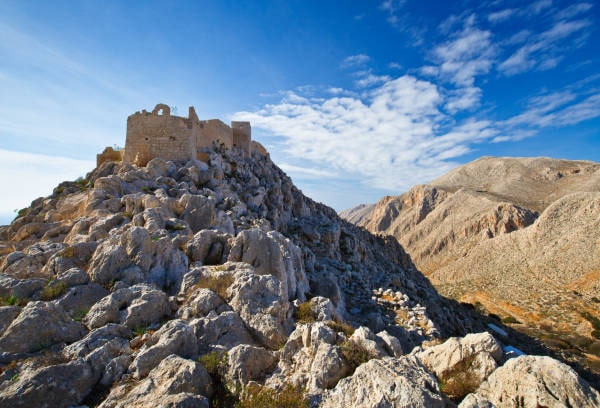
The monastery of Aghios Giannis
The monastery of Aghios Giannis of Alarka is located in a fertile valley and in the past it was cared for by the farmers of the area. However, tradition has also connected the monastery with the spongers of the island, who considered them their patron saint when diving in the surrounding seas, while its despotic icons are donations from people who were engaged in sponge-making.
The Old Village
A 2 miles road, which you can easily walk on foot, taking a slow and enjoyable walk, will bring you to the old capital of Halki, Chorio, with its old stone houses built amphitheatrically around the Castle Hill .
4,000 people lived here, far from the sea for fear of corsairs and pirates, as in almost all the Greek islands. But when this fear disappeared, around 1850 – 1870, the inhabitants of the village founded the seaside Niborio and gradually abandoned their original cradle – the last ones left in 1970 -, which is now deserted.
At the top of the hill, above the Village, dominates the Castle of the Knights, built on the foundations of an older possibly Hellenistic wall, with a view that literally takes your breath away, as it reaches the neighboring Rhodes.
Many small churches and monasteries enrich the list of attractions in Chalki, which is completed by Kamenos Spilios, in the location of Amiglai. There, in 1658, Morosini exterminated the inhabitants hiding in the cave, setting fire to its exit.
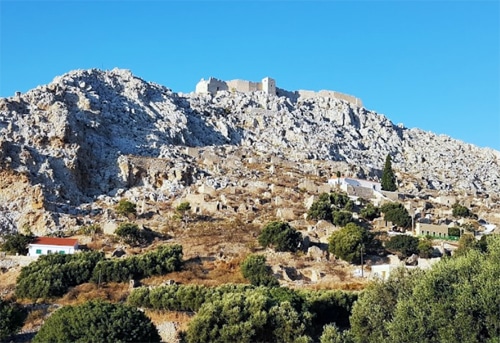
Caves
In 1658 the Venetian Morosini, in order to take revenge on the locals for alerting the Rhodians of his presence, thus overturning his plans for surprise and conquest, exterminated the inhabitants hiding there by lighting a fire at its mouth (at a distance of 8 km from Niborio) .
Visit the cave in Kelia (20 minutes by excursion boat) is an old ascetic dwelling, with paintings on the rock.
Kameno Spilios is a cave in the position “Amiglai’ on a steep rock, in the northwest of the island. In 1658, the Venitian Admiral Francisco Morozini exterminated the dwellers hiding there, by setting the mouth of the cave on fire. In this way Morozini avenged the inhabitants of Halki because they notified the Rhodians of the danger and he thus proved unable to seize Rhodes.
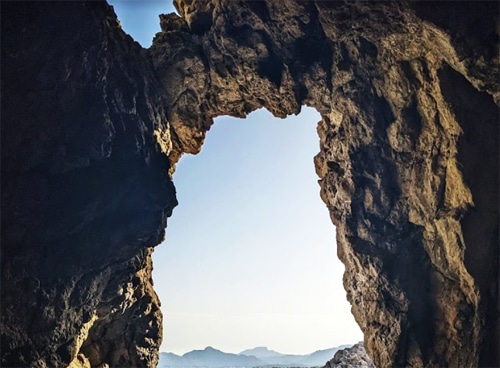
What to do
Go to the the Venetian castle above the old capital of the island, Chorio, visit the monasteries of Taxiarchis, Michael of Panormitis, Ai-Yiannis of Alargas, the church of Agios Nikolaos with the tall beautiful bell tower.
Discover the 360 deserted churches, enjoy the view from the three windmills on the brow of the mountain.
Admire the characteristic stone-built clock of the Town Hall, stroll through the alleys of Emporio, with its magnificent mansions and stare at the huge green lizards basking on the island’s stones.
Enjoy the view from the harbor and let yourself be enchanted by the colours of the mansions that change hour by hour, until the rosy colors of the dusk give way to night. You will find that the island’s port, Emporio, is a painting that changes colours.
Here time loses its dimension. The peace, the quietness, the absolute absence of vehicles and noise pollution are here for anyone who wants peace and isolation. All he has to do is stretch out his hand and the whole island will fit inside.
Culture
Feasts and celebrations
On the eve of the feast of Agios Ioannis of Alarka, the monastery offers pilgrims lamb from its folds baked in the oven with potatoes or macaroni as well as various appetizers. On the next day, a breakfast with honey and a fasting meal is offered. In the courtyard of Ai Giannis of Alarkas, the great festival of Panagia Enniameritis or Ettrias takes place on August 23.
There is also the feast of Aghios Nikolaos on December 6, in Nimborio. Other feasts take place in the monasteries of Stavros on September 14, of Taxiarchis Michail on November 8, and of Aghios Gheorghios on April 23 in Alimia.
Cultural events
Each year, in the month of September, the conference of ELIAMEP (Greek Foundation of European and Foreign Policy) is convened in the island, under the auspices of the Ministry of Foreign Affairs, aiming at the organization of international seminars.
Young politicians, diplomats, scientists and journalists representing various countries participate at the conference where they have the opportunity to get to know the Greek positions on matters of foreign policy.
The conference is co-funded by the Ministries of National Economy, Foreign Affairs and the Aegean, and by the Prefecture
Each year, starting in 1987, several events are organized by the Halki cultural association “Myrtos”, from July to the month of September.
Concerts are given by various groups and artists invited in the island, with the assistance (funding) of the Municipality of Chalki, theatre and theatre of shadows performances are staged and excursions are organized.
Also, in September, concerts are co-organised in the framework of the Symi-Tilos-Halki-Kastelorizo Festival, funded by various sponsors.
Beaches
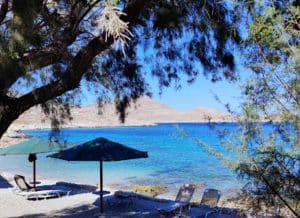
You can get there either by foot or by an excursion boat departing from Nimborio. In the North you can swim in the beaches: Kania, Areta, Aghios Gheorghios, Dyo Ghiali. You get to all of them by boat. There is also the pebbled beach of the island Alimia.
On the beaches of Halki you will enjoy the crystal clear waters. If you prefer sand, head to Pontamos, in the south of the island, which is also easily accessible on foot. Popular beaches are also Kania, Gyaloi or Giali with the white pebbles and Areta, for which, however, you will need a boat.
Day trips
Alimia
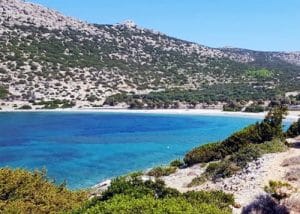
The small island, between Chalki and Rhodes, which in ancient times was called Evlimia, has a large natural harbor, which served as a shelter, a base during the Second World War. The island has been inhabited throughout the ages, since the Neolithic period, as evidenced by the archaeological findings. A Neolithic settlement was identified, while the large quantities of Nisyros and Milos obsidian, which have been found in various parts of the island, are from the same era.
The Castle, built on the island by the Knights of St John in 1475, is an important archaeological site, where the remains of a walled settlement from the Hellenistic and Roman periods can be seen. Remains of the same period can also be found in the port of Agios Georgios.
Daily excursions are organized to the island and you can arrive there in 30 minutes.
Its highest hill has an altitude of 269 m. There is also a small pine-clad bay, its beach covered with pebbles, and two little churches: Aghios Gheorghios and Aghios Minas.
In the triangle between Halki, Alimia and Rhodes there is a complex of islets. Among them you find Aghii Theodori, Makry and Tragousa.
Tourism
As in all other islands of the Dodecanese, tourism tends to become the unique occupation. In recent years, an important hotel and tourist infrastructure has been created in the island. In 1983, Halki has been proclaimed the island of friendship of the youth of the world by the Ministry of Young Generation. The infrastructure works implemented by the ministry, have seriously assisted the tourist development of Halki.
Local cuisine
The variety of local flavors is endless, with the top choice being “ofto”, the Easter goat or lamb, which is stuffed with rice and livers and baked in a traditional wood-fired oven.
Among the fruits of the sea, we can distinguish the bubbles and kolios, Thespesia kakavia, fried “Germanous” and salted smarides, while from the local cheeses we choose mizithra (sweet or salty) and “axevotyriasto”.
The handmade pastas of Halki are also famous, such as the “koulias”, which are shaped like a shell, and the “macarounias”, which are cut into small pieces and cooked a few hours later, to allow them to dry. They are served with cheese and a sauce of onions roasted in butter.
Divine taste with such simple ingredients. The “koulouria” is also a type of pasta, which is cooked either with fresh tomato or with lentils. Lentils star in another local dish, “fakoryzo”, which includes roasted lentils, rice and onion.
Finally, to complete your tasting tour in Halki, look for the famous Halki shrimp, xerotigana, fermented doughnuts drizzled with the wonderful local honey and figs stuffed with sesame.
Try the shrimps (fried or cooked with cheese saganaki-style), fresh fish and seafood.
You can try lamb “ofto” stuffed with bits of liver and rice (cooked in a traditional oven with firewood), salted whitebaits, koulia (handmade macaronis in the shape of sea-shells) Halki-style macaronis (handmade and cut if very thin pieces, cooked after a few hours and served with roasted onions).
Fried fish, sea-food (kochlii and fouskes) fakorizo (roasted lentils with rice and onion), hand-kneaded bread and cheese pie with home-made pastry.
Sweets: Xerotighana, hand-kneaded doughnuts.
How to get to Halki
By ferry
The island of Halki does not have an airport, so you need to fly to Rhodes. During the summer season there is a daily connection with τηε ισλανδ with ferries and tourist boats departing from Kamiro Skala, a small port located on the west coast of Rhodes. The journey from Kamiro Skala to Halki takes about 40 minutes.
There is also a ferry connection between Halki and the central port of Rhodes with passenger ships and catamarans.
In detail, there are the following ways to get to Chalki
By passenger ship from the main port of Rhodes
Halki is only 2 hours away from the main port of Rhodes. A passenger ship passes by Chalki three times a week (twice in the winter months).
It is also served by a passenger ship that leaves from the port of Piraeus and makes a barren route passing by various Aegean islands such as Karpathos, Kasos, Crete etc. The journey time from the port of Piraeus to the island of halki is approximately 24 hours.
The shipping company SAOS ferries operates twice a week itineraries from the port of Rhodes to Halki with an intermediate station in Symi. You can visit the website www.saos.gr for more information.
With daily passenger ferries from Kamiro Skala, Rhodes.
There are daily ferries that run the route Kamiros Skala – Halki every day. Kamiros Skala is a small port on the west coast of Rhodes and is 35 km from Rhodes airport. The route from Kamiro Skala to Halki takes about 40 minutes. Their departure is daily and during the summer season due to increased demand there are additional routes.
As their departure and arrival times may change, it would be preferable to first contact the Port Authority of Chalki at tel: 2246 0 45220.
.
